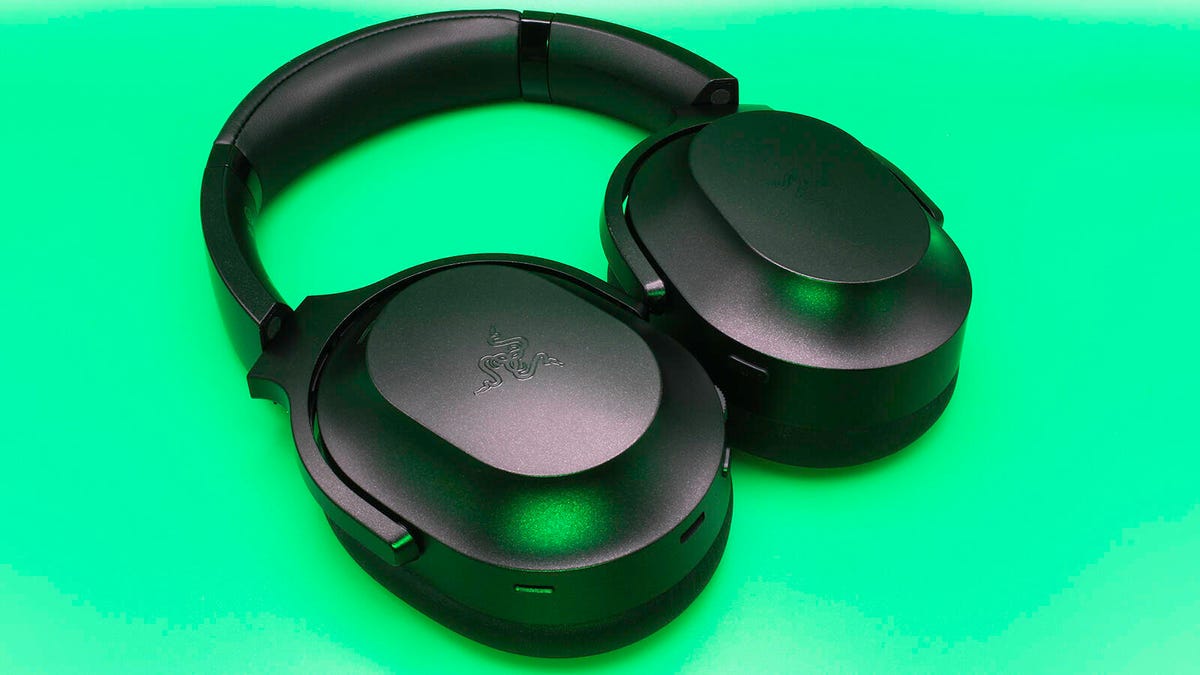Razer Barracuda Pro review: Active noise ruination
Pros
- Solid build quality
- Somewhat weighty but reassuring construction
- Muted aesthetics make it usable anywhere
- Improved bass compared to Razer’s previous flagship wireless headset
Cons
- Turning ANC on flat out ruins some games’ audio
- USB-C dongle’s design makes it a potential problem
- USB-C port doesn’t support audio or firmware updates
- Lacks 3.5mm support for wired use, despite the cheaper version including it
Razer’s past few generations of flagship PC gaming headsets have been its most divergent. First, the Blackshark V2 line arrived, looking less like Razer’s traditional Kraken aesthetic and more like something a helicopter pilot would wear. Then, the Kraken line itself (V3, to be specific) was updated with cleaner lines and smaller-looking earcups.
Now Razer is again breaking the mold for its refreshed Barracuda line of “hybrid gaming & street” headsets. Just like the Blackshark V2s before it, this line eschews design cues from its predecessors in favor of a style seen elsewhere: premium noise-canceling headphones from the likes of Sony, Bose, and other premium audio equipment makers.
This shaped the Barracuda Pro I’m reviewing today into a strange mix of features that nails media consumption use cases while leaving behind core priorities the company is known for. The result is a device that barely looks like a headset (thanks to the lack of any recognizable microphone) and struggles to justify its price point due to a major flaw in the very feature meant to define it. Let’s take a look at Razer’s most confusing and frustrating product in years.
Specifications
| Type | Over-ear wireless |
|---|---|
| Connections | 2.4GHz wireless or Bluetooth 5.2 |
| Audio specs | Frequency response: 20 Hz – 20 kHz | Imedpance: 32 Ω | Driver size: 50mm |
| Charging | USB-A to USB-C cable provided |
| Battery life | 40 hours |
| Microphone | “Dual Integrated MEMS Beamforming Noise-Canceling” |
| RGB lighting | No |
| Supported platforms | PC, Mac, Nintendo Switch, PlayStation 4/5, mobile devices |
| Weight | 340g (0.75 pounds) |
Despite being almost entirely plastic, the headset feels solid in hand. Michael Gariffo
Form and build quality
As mentioned above, the inspirations for the Barracuda line are clear. Also obvious is the fact that Razer wanted to create a headset you’d be happy to wear everywhere.
The only branding on the Pro model is a modest black-on-black Razer logo on the earcups, and the only use of the company’s trademark shade of green is a tiny accent on the mic mute button. This creates a sleek, clean aesthetic that any on-the-go listener should be comfortable sporting in public.
Despite the fact that the Barracuda Pro is constructed almost entirely of plastic (excluding the metal internal headband), it feels reassuringly sturdy. All pivot points turn smoothly, and its adjustments click into place satisfyingly. It feels like it should last many years under anything but obscene amounts of abuse.
The earcups aren’t very deep, but the materials inside make up for it with their softness and lack of any annoying friction. Michael Gariffo
Comfort
The Barracuda Pro just feels comfy. Its soft leatherette material and memory foam ear cushions create enough of a seal to aid in passive noise isolation — without inducing any undue heat or sweating. The earcups are also covered with foam that covers the 50mm TriForce Bio-Cellulose drivers. It’s ultra-soft, making any contact with your ear a pleasant experience.
I should note one minor gripe: the earcups only rotate in one direction. This means if you like rotating them flat when worn around your neck, the drivers will have to face outward. It’s a less than ideal scenario for comfort and protecting the built-in drivers.
More: The best gaming chairs
Razer’s headbands have always had some of the largest adjustment ranges of any gaming models I’ve used, and the Barracuda Pro is no exception. It easily fit my above-average-sized head with room to spare, and the included padding let me wear it all day without any hotspots, pressure points, or other annoyances.
The controls are easy to use by feel once you get used to their placement. Michael Gariffo
Controls
The left earcup includes the USB-C charging port, a digitally controlled volume dial (which directly alters your OS volume level), a mic mute button, and a power button that can also serve as a play/pause and track skip button.
The only control on the right earcup is the SmartSwitch button. One tap of this toggles through ANC on, ANC off, and Ambient modes (each audibly announced by the headset). The last one uses the headset’s external microphones to directly pass sound to your ears if you need to hear the world around you a bit better.
The SmartSwitch button controls both your listing mode (ANC on/off and Ambient) and your ability to swap between the 2.4GHz audio source and a Bluetooth source. Michael Gariffo
I will say the weight added by the included ANC technology was noticeable. Despite the Barracuda Pro only weighing 20g more than the Razer Blackshark V2 Pro I use on a daily basis (340g versus 320g), it felt heavier than expected. I’m not sure if it’s the weight distribution, but I clocked the difference immediately.
More: Razer Blackshark V2 Pro headset review: A potent weapon for the right gamer
Still, the Barracuda Pro is one of the most comfortable gaming headsets I’ve worn thanks to its material choices, ergonomically shaped earcups, and excellent cushioning.
The case is hard-sided and includes a small compartment for all of the required accessories with a nice magnetic lid. Michael Gariffo
Connectivity
The Barracuda Pro supports 2.4GHz wireless and Bluetooth 5.2, which you can swap between by double-tapping the SmartSwitch button. The former is the preferable mode for gaming use, thanks to its lower latency. The latter lets the headset connect to just about anything that supports Bluetooth audio, including smartphones, tablets, PCs, streaming devices, and so on.
This versatility is the basis of the best case one could make for the Barracuda Pro’s $250 cost: it truly is an all-in-one solution that can function as a headset for gaming, taking voice calls, listening to music, and streaming audio from videos. This gives it the potential to replace multiple other headsets.
Left to right: USB-A to USB-C charging cable, 2.4GHz USB-C dongle, and a USB-A to USB-C extension cable for the dongle. Michael Gariffo
2.4GHz performance
The 2.4GHz connection requires the included USB-C dongle to function. Razer’s design for that dongle, while significantly smaller than USB-A equivalents, can be much more problematic.
Rather than extending straight out from the port, the transmitter is L-shaped, with the actual USB-C connector located at one end, as you can see above. This can block ports located next to the transmitter or make the dongle unusable in ports located too close to a PC case’s sidewall. The inherent ability for USB-C connectors to be inverted will ameliorate this somewhat, but it could still have unfortunate consequences for some users. Even the included USB-A to USB-C extension cable that can correct this issue ends up looking odd with the USB-C dongle sticking out of one side.
More: Sony INZONE H9 review: The XM5 of gaming headphones
The actual 2.4GHz connection provided by the dongle, however, is excellent. Even in a room with considerable RF interference, including from another Razer wireless headset, it performed very well, reaching its ascribed range and only cutting out once or twice — for a split second — over a full day’s use.
Bluetooth performance
Bluetooth performance was equally steady in normal use for music and video. However, the Game Mode that Razer has provided in its Razer Audio App and on the headset itself was more finicky. It attempts to reduce the latency that makes Bluetooth inadequate for serious gaming use, but it does so at the cost of considerable range and some audio fidelity (at least in my testing). This meant I had to stay much closer to the audio source.
This isn’t problematic if that source is a smartphone held in hand, but it’s less viable for any further-flung devices.
You can charge the headset while it’s being worn and used, but your audio connection still requires 2.4GHz or Bluetooth connectivity. Michael Gariffo
Power and charging
Charging is accomplished via the included USB-A to USB-C charging cable, which plugs into the left earcup. I found the headset mostly matched its claimed 40-hour runtime — assuming I had ANC off for most of that and kept my volume at a moderate level. This included a mix of both 2.4GHz and Bluetooth use.
If you hadn’t guessed, all of those variables (connection type, ANC, range, interference, etc.) meant the battery duration could vary considerably, but this is true of just about any headset. I’d say most users won’t have to charge this unit more than once a week with an average amount of use.
More: The perfect USB-C charging cable: Power meter included
That charging process is quick and easy to track thanks to the fact that Razer finally added a true percentage indicator to its companion software. No more squinting at the tiny battery icon to guess what the exact charge level of your headset is, which was necessary for some past models.
I should note the USB-C port appears to be for charging only. I needed to update the unit’s firmware, a 20-minute process I’ll explain momentarily. But, even with the cable plugged directly into my PC, I still needed to establish a 2.4GHz connection in order for the update to start.
There’s also no 3.5mm port for wired use, nor can the USB-C connection supply audio. You can, however, use the headset normally via its wireless connections while it’s charging.
Here is one of the headset’s microphones used for both voice pickup and ANC on prominent display. Michael Gariffo
Sound
This is where the wheels start to come off. As a Razer product, this headset is marketed to gamers. Like any gaming headset, you can obviously still use it for music, movies, etc. Gaming headsets typically excel at gaming, while providing varying, often inferior, levels of quality when used for other purposes. This was definitely not the case for the Barracuda Pro.
The big problem with the Barracuda Pro
The main issue with the headset became apparent when I ran a test of its in-game directional sound, an utterly vital portion of gaming headset performance for FPS players. To be clear, I was able to quickly and accurately locate sound sources using the headset, even with my eyes closed.
However, during testing, I noticed the gunshot sounds that I’m so intimately familiar with from previous tests, sounded…wrong. They were hollow, subdued, and there was some odd reverb being added to them.
At first, I attributed this to the fact that I’d ignored the headset’s notification that a firmware update was available for it upon first trying it out. So, I cut my test session short and began the process of updating the firmware.
More: The 5 best noise-canceling headphones
As mentioned above, this took 20 minutes. The firmware install itself accounted for five. The rest was taken up by the lengthy, unfortunately frequent need to update Razer Synapse. Mind you, I’d just updated it for my review of the excellent Razer Viper V2 Pro. Despite that, it still needed a multi-stage update with a PC restart. Only after this would the firmware update proceed.
With that finally done, I re-entered the test scenario and nothing had changed. The sound was still hollow; the weird reverb was still there. I began to wonder if a setting was messed up, leading to an extended period of tweaking every variable in both the game’s sound settings and in Razer’s Synapse.
What ended up being the culprit, after much investigation, was the device’s own active noise-cancelation mode. And that, as you can guess, is a big problem.
Here is the right earcup’s equivalent microphone. Michael Gariffo
But with ANC turned off…
Without the ANC on, the game sounded rich and immersive, with excellent sound staging, perfect directionality, and bass that’s much improved over the Blackshark V2 Pro headset (which has been my personal main for about a year). Simply put, it sounded like a mid- or even high-end gaming headset should.
This is where I must note the Barracuda Pro sells for $100 more than the standard Barracuda (MSRP: $150). The only benefit over the cheaper headset is the added ANC functionality and the Pro’s compatibility with Razer’s Android and iOS apps — which exist, in part, to control that ANC. Meanwhile, the standard Barracuda is 20g lighter and includes the 3.5mm connectivity for wired use that the Pro model lacks.
More: The best headphones for workouts and running
To be clear, the difference in sound quality between having ANC on and ANC off varied from game to game. While it was detectably worse across all titles, the difference was almost negligible in Halo Infinite, middling annoyance in Apex Legends, and downright disastrous in Overwatch and the ongoing Overwatch 2 Beta. No one wants to gamble with whether or not a headline feature (one they’re paying a $100 premium for) will ruin the audio of their game of choice.
The same hidden microphones that power the unit’s ANC are also what replaces a boom mic for voice chat purposes, as seen in Razer’s promo imagery. Razer
The tragedy of it all
And this is a particular shame because that noise cancelation is quite impressive, as I discovered somewhat by accident.
I was testing out the Barracuda Pro in Halo Infinite when I felt my very large golden retriever trying to stuff himself in the very small space below my desk. Wondering what had scared him into his usual safe spot, I removed the headset to find that a severe thunderstorm was in progress. By the looks of things once I opened the shades, it had been storming for some time. I’d heard none of it.
There is good news about this war between audio quality and ANC: it doesn’t affect music nearly as much. Whether over 2.4GHz wireless or Bluetooth, music sounded superior to any other Razer headset I’ve tested. That richer bass I mentioned was joined by clear vocals, quiet spaces between instrumental notes, and satisfyingly sharp highs across vocals and instruments.
More: The 5 best PC gaming headsets: Premium audio, no drops
Everything I’ve said about music can also be applied to movies, but not to games. The only situation where I can see ANC providing a better overall experience for games is if your surroundings are so loud that ongoing ambient noise would worsen your audio experience more than the negative impact of ANC itself.
Outside of those cacophonous scenarios, I can’t recommend using ANC for gaming, especially if you’re trying to be competitive. The downgrade in audio is too impactful on your general ability to enjoy and recognize in-game sound, even if you can still tell the general directions your enemies are approaching from.
Microphone performance
As always, I think the best way to experience how a mic sounds is to hear it for yourself. So, I created the above demo of the Barracuda Pro’s built-in mic, and I included a comparison with the more traditional boom mic that ships with Razer’s previous flagship Blackshark V2 Pro headset.
Like most wireless headset microphones, the Barracuda Pro’s mic sounds passable but not great. It suffers from the same slightly compressed-sounding voice quality as the Blackshark V2 Pro’s mic did, but it’s a bit harder to get to an adequate volume without adding distortion, thanks to the physical placement of the microphones referenced in the past several images. I also found it more prone to ambient noise interference for the same reason. Some of the built-in processing settings detailed in the video can help with this, but the effect those settings have on audio is noticeable.
More: Best microphones for streaming: From Twitch to podcasts
The built-in mic in the Barracuda Pro will certainly get you by for the basic call-outs needed during most in-game voice chat, but I certainly wouldn’t attempt to kick off your career as a podcaster or streamer using it.
Bottom line
Despite what may seem like a generally bleak outlook on the overall audio performance of the Barracuda Pro, it’s important to note that this could still be an excellent audio solution for the right person. If you’re happy with using the headset with ANC off during gaming and ANC on for music, that’s a big point in its favor. But, to justify that $250 price point, I’d say you’d need to use this headset for all of your audio needs.
If you’re replacing something like the aforementioned Blackshark V2 Pro (which sells for around $100-$125 now) and a solid pair of noise canceling, over-ear mobile headphones, like well-known models from Sony or Bose ($200-$400), this headset is the better value proposition: you’re replacing $300 to $525 worth of equipment with a single, $250 item.
If you’re a fan of clean and simple aesthetics, it’s hard to dislike the Barracuda Pro’s looks. Michael Gariffo
However, I can’t say the Barracuda Pro is truly superior to the Blackshark V2 Pro for gaming, nor is it a full match for something like Sony’s WH-1000XM4 headphones. Yes, we’re approaching a “jack of all trades, master of none” situation here. But that’s not necessarily a disqualifying factor, just a limiting one.
If you happen to be a person simultaneously in need of solid, comfortable, and affordable solutions for both your gaming headset needs and your media consumption requirements, the Barracuda Pro is still worth a look (especially if it sees the eventual discounts Razer products tend to over time). Conversely, if you need a single-purpose gaming headset, I can’t recommend spending $100-$150 more on this than Razer’s former flagship or the standard Barracuda model — not for ANC that may not even be viable for your game of choice.
If Razer finds a way to correct this via software or firmware update, I’ll update this review to reflect that. Until then, there are much more affordable options out there with equivalent sound quality, even in Razer’s own current lineup.
Alternatives to consider
If you like everything about the Barracuda Pro headset but would rather skip the problematic ANC issues, its cheaper sibling keeps every other feature intact for $100 less.
Razer’s previous flagship wireless headset has made its way under $100, making it an incredible bargain if you just want a meat and potatoes competitive gaming headset. Read my full review here.
Steelseries’ flagship is a bit pricier than the Barracuda Pro, but ZDNet’s own Rebecca Isaacs found its ANC much less problematic in her full review, and its cleverly hidden boom mic offers a more traditional voice chat experience.





Pingback: 토렌트 사이트
Pingback: bio ethanol burner
Pingback: ufabtb
Pingback: 25 hp mercury,
Pingback: scam site
Pingback: วิเคราะห์บอล